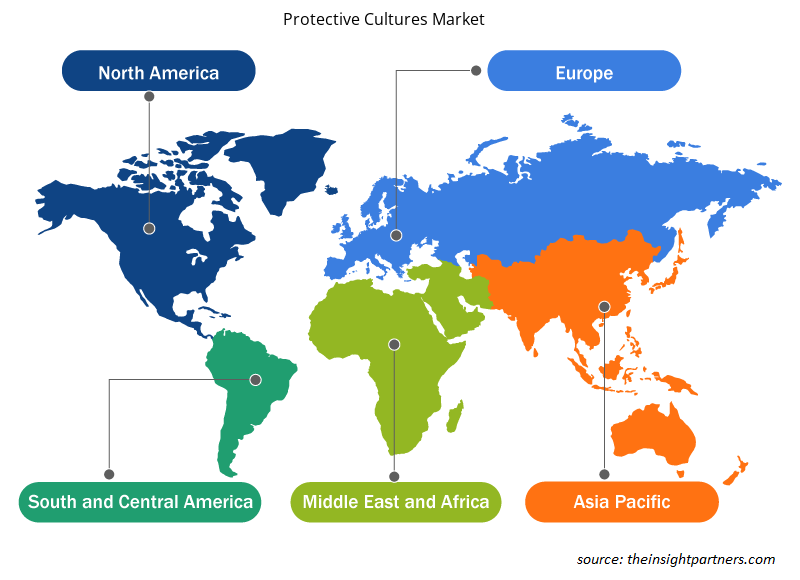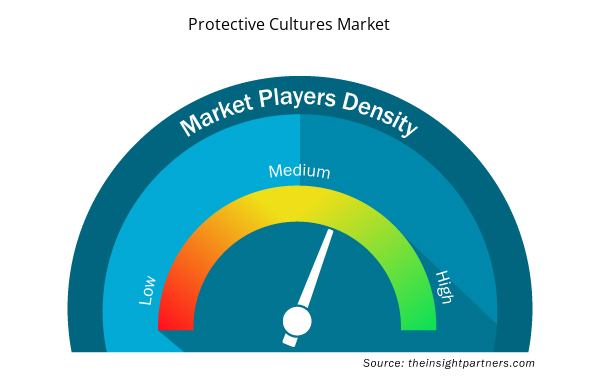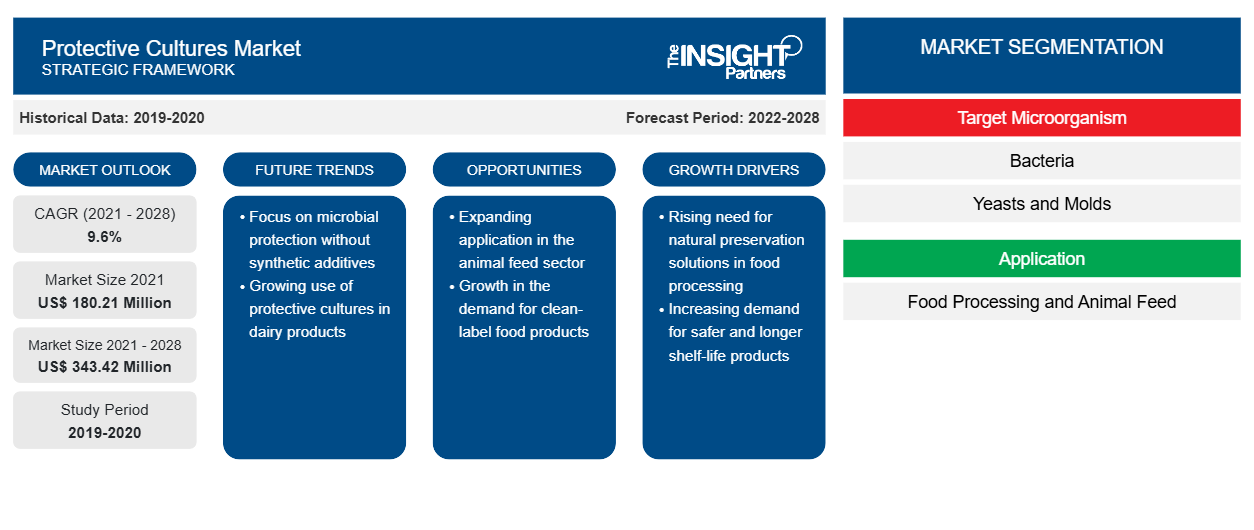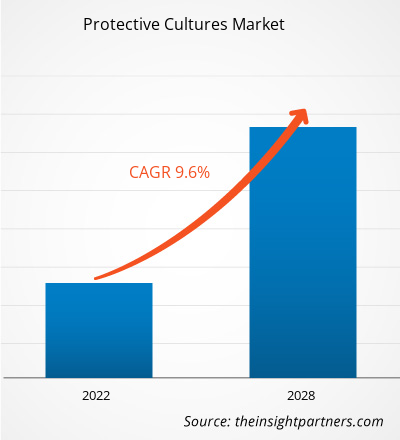[Rapporto di ricerca] Si prevede che il mercato delle colture protettive crescerà da 180,21 milioni di dollari nel 2021 a 343,42 milioni di dollari entro il 2028; si stima che crescerà a un CAGR del 9,6% dal 2021 al 2028.
La crescente domanda di prodotti naturali e privi di conservanti chimici, nonché la crescente domanda di prodotti deperibili con una lunga durata di conservazione in tutto il mondo, stimolano la crescita del mercato delle colture protettive.
Si prevede che il mercato delle colture protettive nell'area Asia-Pacifico crescerà al CAGR più elevato durante il periodo di previsione. La Cina è il mercato di prodotti lattiero-caseari più importante ed è trainata principalmente dal crescente consumo di prodotti lattiero-caseari. La crescente domanda di prodotti lattiero-caseari come snack naturali, prodotti lattiero-caseari fermentati come latte acido e yogurt, unita alle innovazioni di prodotto e imballaggio, sta guidando la crescita del mercato dei prodotti lattiero-caseari nell'area Asia-Pacifico. Pertanto, si prevede che il mercato delle colture protettive assisterà a una crescita significativa nei prossimi anni a causa del crescente consumo di prodotti lattiero-caseari e dei benefici delle colture protettive, come la capacità di inibire la crescita di microrganismi patogeni e deterioranti. Inoltre, la crescente consapevolezza sui prodotti naturali e clean label tra la popolazione asiatica sta successivamente aiutando l'espansione del mercato.
Personalizza questo report in base alle tue esigenze
Riceverai la personalizzazione gratuita di qualsiasi report, comprese parti di questo report, o analisi a livello nazionale, pacchetto dati Excel, oltre a usufruire di grandi offerte e sconti per start-up e università
- Scopri le principali tendenze di mercato in questo rapporto.Questo campione GRATUITO includerà analisi di dati che spaziano dalle tendenze di mercato alle stime e alle previsioni.
Impatto della pandemia di COVID-19 sul mercato delle colture protettive
L'attuale pandemia di COVID-19 ha avuto un impatto relativamente positivo sul mercato delle colture protettive. La pandemia ha contribuito a sviluppare un interesse e una consapevolezza relativi alle colture microbiche. La crisi è stata un periodo spiacevole e stressante per la maggior parte della popolazione in tutto il mondo. Pertanto, le persone in tutto il mondo hanno iniziato a consumare prodotti clean label. Dopo l'avvento della pandemia di COVID-19, le persone sono diventate più caute riguardo al cibo e stanno consumando cibo più sano rispetto alla dieta abituale. La pandemia di COVID-19 ha cambiato la percezione del consumatore di clean beyond label o prodotti. I consumatori continuano a mantenere la loro attenzione sul clean label per gli acquisti a casa e fuori casa, il che sta aumentando l'applicazione del clean label nelle varie applicazioni alimentari. Inoltre, le prospettive di progresso economico nella maggior parte dei paesi sono ottimistiche per il 2021.
Approfondimenti di mercato
Aumento del consumo di latticini
Il mercato lattiero-caseario si sta evolvendo in tutto il mondo. I consumatori preferiscono prodotti lattiero-caseari migliori per te, naturali e sostenibili con elenchi di ingredienti più brevi e una maggiore trasparenza sull'etichettatura dei prodotti. Con i crescenti stili di vita moderni e frenetici, c'è una crescente domanda di opzioni comode che possono essere consumate in movimento senza dover essere refrigerate per mantenerle fresche. Le colture protettive sono importanti nel supportare i produttori di latticini nell'aggiungere ai loro profitti evitando il deterioramento durante la durata di conservazione, soddisfacendo così le esigenze dei consumatori di prodotti naturali e con etichetta pulita. Inoltre, il consumo di latticini, come yogurt, burro e formaggio, sta aumentando in tutto il mondo.
Il formaggio è diventato un componente primario nelle diete quotidiane in tutto il mondo. Secondo il Dipartimento dell'agricoltura degli Stati Uniti, nel 2017 sono state prodotte 5.733 tonnellate di formaggio nel paese e le persone in Nord America consumano in media circa 6.626 tonnellate di formaggio all'anno. Il mercato del formaggio è anche uno dei principali utilizzatori finali di colture protettive a causa della specifica coltura protettiva utilizzata contro la Listeria. È realizzata con Lactobacillus plantarum ed è efficace nel prevenire la formazione di Listeria sui formaggi stagionati con superficie rossa ad alto rischio. Da qui in poi, questi fattori sopra menzionati guidano la domanda di formaggio nel mercato delle colture protettive. Inoltre, aziende come DuPont Danisco e Chr Hansen hanno una presenza significativa nel mercato dei prodotti lattiero-caseari con estese colture protettive. Con la crescente domanda di prodotti lattiero-caseari naturali e sani, i prodotti a etichetta pulita e a etichetta verde stanno assistendo a un'enorme domanda nel settore lattiero-caseario.
Approfondimenti sui microrganismi target
In base al microrganismo target, il mercato delle colture protettive è diviso in batteri, lieviti e muffe. Il segmento dei lieviti e delle muffe ha rappresentato una quota di mercato maggiore nel 2020. I lieviti sono un sottoinsieme dei funghi, un ampio gruppo di organismi che include anche muffe e funghi. Sono in genere organismi unicellulari che si sono evoluti per vivere in ambienti specializzati. Il lievito in genere colonizza cibi ad alto contenuto di sale o zucchero, come sottaceti, sciroppo d'acero e altri, che contribuiscono al loro deterioramento. Frutta e liquidi con un pH basso sono altri target e ci sono alcuni lieviti che si sviluppano sulle superfici di carne e formaggio. Le muffe sono composte da milioni di cellule microscopiche che sono collegate tra loro per creare catene e possono essere trovate su pane, frutta, carta umida e altre superfici. Possono rovinare cibi secchi, pesce salato, frutta, gelatine, pane, sottaceti, marmellate e altri prodotti simili.
Approfondimenti sulle applicazioni
In base all'applicazione, il mercato delle colture protettive è diviso in trasformazione alimentare e mangimi per animali. Il segmento della trasformazione alimentare ha rappresentato una quota di mercato maggiore nel 2020, mentre si prevede che il segmento dei mangimi per animali registrerà un CAGR più elevato nel mercato durante il periodo di previsione. La trasformazione alimentare comprende vari settori come prodotti lattiero-caseari; bevande; e prodotti a base di carne, pollame e frutti di mare. C'è un uso crescente di colture protettive, specialmente nei settori lattiero-caseario, della carne e dei frutti di mare, poiché sono generalmente riconosciute come sicure (GRAS) per il consumo e predominano naturalmente nel microbiota di molti alimenti. Inoltre, a causa della necessità di prodotti con una maggiore durata di conservazione, i trasformatori alimentari stanno utilizzando sempre più colture protettive. Inoltre, i consumatori stanno diventando consapevoli che una grande quantità di spreco alimentare è causata dal deterioramento e dalla crescita di muffe. Ciò influisce anche sulla redditività dei trasformatori alimentari; quindi, i trasformatori utilizzano colture protettive per ridurre lo spreco alimentare. Pertanto, la domanda di questi prodotti è in aumento nel settore alimentare. Le colture protettive sono fondamentali per aiutare i produttori lattiero-caseari a migliorare i loro prodotti, evitandone il deterioramento durante tutta la durata di conservazione, prolungando la durata di conservazione e soddisfacendo nel contempo la domanda dei consumatori di prodotti naturali e più puliti.
Tra i principali attori del mercato delle colture protettive rientrano Biochem Srl, Bioprox, Chr. Hansen Holding A/S, Meat Cracks Technologie GmbH, DSM, Lallemand Inc., International Flavors & Fragrances Inc., Kerry Group, Sacco System e Dalton Biotechnologies Srl. Le aziende chiave adottano strategie quali fusioni e acquisizioni, nonché ricerca e sviluppo per espandere la base clienti e ottenere una quota significativa nel mercato globale, il che consente loro anche di mantenere il proprio marchio a livello globale.
Approfondimenti regionali sul mercato delle colture protettive
Le tendenze regionali e i fattori che influenzano il mercato delle colture protettive durante il periodo di previsione sono stati ampiamente spiegati dagli analisti di Insight Partners. Questa sezione discute anche i segmenti e la geografia del mercato delle colture protettive in Nord America, Europa, Asia Pacifico, Medio Oriente e Africa e America meridionale e centrale.

- Ottieni i dati specifici regionali per il mercato delle colture protettive
Ambito del rapporto di mercato sulle colture protettive
| Attributo del report | Dettagli |
|---|---|
| Dimensioni del mercato nel 2021 | 180,21 milioni di dollari USA |
| Dimensioni del mercato entro il 2028 | 343,42 milioni di dollari USA |
| CAGR globale (2021 - 2028) | 9,6% |
| Dati storici | 2019-2020 |
| Periodo di previsione | 2022-2028 |
| Segmenti coperti | Per microrganismo bersaglio
|
| Regioni e Paesi coperti | America del Nord
|
| Leader di mercato e profili aziendali chiave |
|
Densità degli attori del mercato delle culture protettive: comprendere il suo impatto sulle dinamiche aziendali
Il mercato delle colture protettive sta crescendo rapidamente, spinto dalla crescente domanda degli utenti finali dovuta a fattori quali l'evoluzione delle preferenze dei consumatori, i progressi tecnologici e una maggiore consapevolezza dei benefici del prodotto. Con l'aumento della domanda, le aziende stanno ampliando le loro offerte, innovando per soddisfare le esigenze dei consumatori e capitalizzando sulle tendenze emergenti, il che alimenta ulteriormente la crescita del mercato.
La densità degli operatori di mercato si riferisce alla distribuzione di aziende o società che operano in un particolare mercato o settore. Indica quanti concorrenti (operatori di mercato) sono presenti in un dato spazio di mercato in relazione alle sue dimensioni o al valore di mercato totale.
Le principali aziende che operano nel mercato delle colture protettive sono:
- Biochem Srl
- Bioprotezione
- Società a responsabilità limitata Hansen Holding A/S
- Meat Cracks Technologie GmbH
- Il DSM-5
Disclaimer : le aziende elencate sopra non sono classificate secondo un ordine particolare.

- Ottieni una panoramica dei principali attori del mercato delle colture protettive
Segnala i riflettori
- Tendenze industriali progressive nel mercato delle colture protettive per aiutare gli operatori a sviluppare strategie efficaci a lungo termine
- Strategie di crescita aziendale adottate dai mercati sviluppati e in via di sviluppo
- Analisi quantitativa del mercato delle colture protettive dal 2019 al 2028
- Stima della domanda globale di cultura protettiva
- Analisi delle cinque forze di Porter
- Sviluppi recenti per comprendere lo scenario competitivo del mercato
- Tendenze e prospettive del mercato, nonché fattori che guidano e frenano la crescita del mercato delle colture protettive
- Assistenza nel processo decisionale evidenziando le strategie di mercato che sostengono l'interesse commerciale, portando alla crescita del mercato
- La dimensione del mercato delle colture protettive in vari nodi
- Panoramica dettagliata e segmentazione del mercato, nonché dinamiche del settore della cultura protettiva
- Dimensioni del mercato delle colture protettive in diverse regioni con promettenti opportunità di crescita
Mercato delle colture protettive – per microrganismo target
- Batteri
- Lievito e muffa
Mercato delle colture protettive – per applicazione
- Lavorazione alimentare
- Prodotti lattiero-caseari
- Bevande
- Prodotti a base di carne, pollame e pesce
- Altri
- Mangime per animali
Profili aziendali
- Biochem Srl
- Bioprotezione
- Società a responsabilità limitata Hansen Holding A/S
- Meat Cracks Technologie GmbH
- Il DSM-5
- Lallemand Inc.
- Aromi e fragranze internazionali Inc.
- Gruppo Kerry
- Sistema Sacco
- Dalton Biotecnologie Srl
- Analisi storica (2 anni), anno base, previsione (7 anni) con CAGR
- Analisi PEST e SWOT
- Valore/volume delle dimensioni del mercato - Globale, regionale, nazionale
- Industria e panorama competitivo
- Set di dati Excel


- Space Situational Awareness (SSA) Market
- Medical Second Opinion Market
- Fertilizer Additives Market
- Vessel Monitoring System Market
- Ceiling Fans Market
- Resistance Bands Market
- Water Pipeline Leak Detection System Market
- Arterial Blood Gas Kits Market
- Medical Collagen Market
- Vision Guided Robotics Software Market

Report Coverage
Revenue forecast, Company Analysis, Industry landscape, Growth factors, and Trends

Segment Covered
This text is related
to segments covered.

Regional Scope
North America, Europe, Asia Pacific, Middle East & Africa, South & Central America

Country Scope
This text is related
to country scope.
Domande frequenti
By application, the global protective cultures market is bifurcated into food processing and animal feed. The food processing segment is further bifurcated into dairy products; beverages; meat, poultry, & seafood products; and others. The food processing segment dominated the market in 2020 and is expected to maintain its dominance throughout the forecast period. However, the animal feed segment is expected to register a higher growth rate during the forecast period 2021–2028.
The overall threat of rivalry in protective culture market is high. Rivalry is considered to be a high threat to profit when there are more than two competitors of similar size. Herein, competitive rivalry is intense as the industry’s products are more or less undifferentiated. This makes for intense rivalry because competitors are constantly seeking ways to reach a competitive advantage over one another to gain market share. Moreover, all the market players compete on the basis of cost, product quality, and after sales service to name a few.
The global protective cultures market growth is majorly influenced by determinants such as rising demand for dairy products, increasing adoption of natural preservatives, rising focus on reducing food wastage.
In 2020, Europe accounted for the largest share in the global protective cultures market. Europe is amongst the largest markets for protective cultures owing to the well-established dairy industry, rising adoption of various food safety trends, and growing innovations across the food & beverages sector in the region. Consumers across Europe prefer natural, organic, and sustainable dairy products that are minimally processed and contain simple ingredients. In addition, transparent product labelling helps health-conscious consumers across the region have a better knowledge of the components utilized in dairy products. Therefore, dairy manufacturers are incorporating protective cultures, which are specialized bacteria, to inhibit the growth of pathogenic organisms or microbiological deterioration agents.
The major players operating in the global protective cultures market are Biochem Srl, Bioprox, Chr. Hansen Holding A/S, Meat Cracks Technologie GmbH, DSM, Lallemand Inc., International Flavors & Fragrances Inc., Kerry Group, Sacco System, and Dalton Biotechnologies S.r.l.
Based on target microorganism, the protective cultures market is segmented into bacteria, and yeasts & molds. The yeasts & molds segment held a larger share in the global protective cultures market in 2020. Yeast and molds are two of the most important contaminants that impact food quality. The use of a protective culture helps reduce wastage and spoilage caused by these microbes. Yeast typically colonizes on high-salt or high-sugar foods, such as pickles, maple syrup, and others, which contribute to their deterioration. Fruits and liquids with a low pH are other targets, and there are some yeasts that develop on the surfaces of meat and cheese.
Trends and growth analysis reports related to Food and Beverages : READ MORE..
The List of Companies - Protective Cultures Market
- Biochem Srl
- Bioprox
- Chr. Hansen Holding A/S
- Meat Cracks Technologie GmbH
- DSM
- Lallemand Inc.
- International Flavors & Fragrances Inc.
- Kerry Group
- Sacco System
- Dalton Biotechnologies S.r.l
The Insight Partners performs research in 4 major stages: Data Collection & Secondary Research, Primary Research, Data Analysis and Data Triangulation & Final Review.
- Data Collection and Secondary Research:
As a market research and consulting firm operating from a decade, we have published and advised several client across the globe. First step for any study will start with an assessment of currently available data and insights from existing reports. Further, historical and current market information is collected from Investor Presentations, Annual Reports, SEC Filings, etc., and other information related to company’s performance and market positioning are gathered from Paid Databases (Factiva, Hoovers, and Reuters) and various other publications available in public domain.
Several associations trade associates, technical forums, institutes, societies and organization are accessed to gain technical as well as market related insights through their publications such as research papers, blogs and press releases related to the studies are referred to get cues about the market. Further, white papers, journals, magazines, and other news articles published in last 3 years are scrutinized and analyzed to understand the current market trends.
- Primary Research:
The primarily interview analysis comprise of data obtained from industry participants interview and answers to survey questions gathered by in-house primary team.
For primary research, interviews are conducted with industry experts/CEOs/Marketing Managers/VPs/Subject Matter Experts from both demand and supply side to get a 360-degree view of the market. The primary team conducts several interviews based on the complexity of the markets to understand the various market trends and dynamics which makes research more credible and precise.
A typical research interview fulfils the following functions:
- Provides first-hand information on the market size, market trends, growth trends, competitive landscape, and outlook
- Validates and strengthens in-house secondary research findings
- Develops the analysis team’s expertise and market understanding
Primary research involves email interactions and telephone interviews for each market, category, segment, and sub-segment across geographies. The participants who typically take part in such a process include, but are not limited to:
- Industry participants: VPs, business development managers, market intelligence managers and national sales managers
- Outside experts: Valuation experts, research analysts and key opinion leaders specializing in the electronics and semiconductor industry.
Below is the breakup of our primary respondents by company, designation, and region:

Once we receive the confirmation from primary research sources or primary respondents, we finalize the base year market estimation and forecast the data as per the macroeconomic and microeconomic factors assessed during data collection.
- Data Analysis:
Once data is validated through both secondary as well as primary respondents, we finalize the market estimations by hypothesis formulation and factor analysis at regional and country level.
- Macro-Economic Factor Analysis:
We analyse macroeconomic indicators such the gross domestic product (GDP), increase in the demand for goods and services across industries, technological advancement, regional economic growth, governmental policies, the influence of COVID-19, PEST analysis, and other aspects. This analysis aids in setting benchmarks for various nations/regions and approximating market splits. Additionally, the general trend of the aforementioned components aid in determining the market's development possibilities.
- Country Level Data:
Various factors that are especially aligned to the country are taken into account to determine the market size for a certain area and country, including the presence of vendors, such as headquarters and offices, the country's GDP, demand patterns, and industry growth. To comprehend the market dynamics for the nation, a number of growth variables, inhibitors, application areas, and current market trends are researched. The aforementioned elements aid in determining the country's overall market's growth potential.
- Company Profile:
The “Table of Contents” is formulated by listing and analyzing more than 25 - 30 companies operating in the market ecosystem across geographies. However, we profile only 10 companies as a standard practice in our syndicate reports. These 10 companies comprise leading, emerging, and regional players. Nonetheless, our analysis is not restricted to the 10 listed companies, we also analyze other companies present in the market to develop a holistic view and understand the prevailing trends. The “Company Profiles” section in the report covers key facts, business description, products & services, financial information, SWOT analysis, and key developments. The financial information presented is extracted from the annual reports and official documents of the publicly listed companies. Upon collecting the information for the sections of respective companies, we verify them via various primary sources and then compile the data in respective company profiles. The company level information helps us in deriving the base number as well as in forecasting the market size.
- Developing Base Number:
Aggregation of sales statistics (2020-2022) and macro-economic factor, and other secondary and primary research insights are utilized to arrive at base number and related market shares for 2022. The data gaps are identified in this step and relevant market data is analyzed, collected from paid primary interviews or databases. On finalizing the base year market size, forecasts are developed on the basis of macro-economic, industry and market growth factors and company level analysis.
- Data Triangulation and Final Review:
The market findings and base year market size calculations are validated from supply as well as demand side. Demand side validations are based on macro-economic factor analysis and benchmarks for respective regions and countries. In case of supply side validations, revenues of major companies are estimated (in case not available) based on industry benchmark, approximate number of employees, product portfolio, and primary interviews revenues are gathered. Further revenue from target product/service segment is assessed to avoid overshooting of market statistics. In case of heavy deviations between supply and demand side values, all thes steps are repeated to achieve synchronization.
We follow an iterative model, wherein we share our research findings with Subject Matter Experts (SME’s) and Key Opinion Leaders (KOLs) until consensus view of the market is not formulated – this model negates any drastic deviation in the opinions of experts. Only validated and universally acceptable research findings are quoted in our reports.
We have important check points that we use to validate our research findings – which we call – data triangulation, where we validate the information, we generate from secondary sources with primary interviews and then we re-validate with our internal data bases and Subject matter experts. This comprehensive model enables us to deliver high quality, reliable data in shortest possible time.


 Ottieni un campione gratuito per questo repot
Ottieni un campione gratuito per questo repot